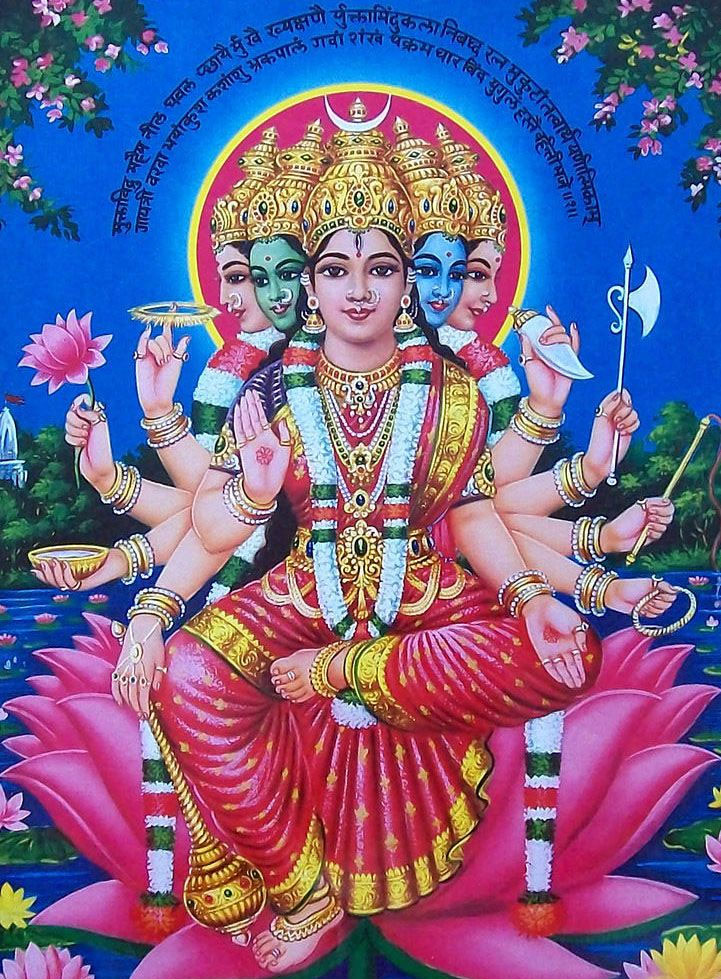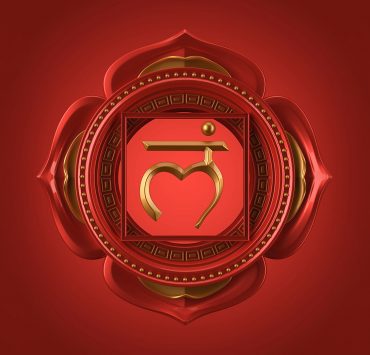
Meditation coach Emma Morrison is the go-to person for those…
Among the many mantras in yoga, there is the Gayatri Mantra. In Sanskrit, it is written as follows:
“Om bhur bhuvah svah tat savitur varenyam bhargo devasya dhimahi dhiyo yo nah prachodayat”
Below is a popular translation by Douglas Brooks, Ph.D. He is a Professor of Religion at the University of Rochester and a teacher of the Rajanaka yoga tradition.
“The eternal, earth, air heaven
That glory, that resplendence of the sun
May we contemplate the brilliance of that light
May the sun inspire our minds”
Breaking Down the Gayatri Mantra

OM = primeval sound
This is a mystic syllable. It is considered the most sacred mantra in Hinduism and Tibetan Buddhism. The sound of the om is the vibration from which the entire universe has been manifested.
BHUR = physical body or physical realm
Bhur is the embodiment of a vital spiritual energy. It implies existence. Bhur can also mean Earth and life. Earth is where we are all born and sustained. And life is what is given to all beings on this earth.
BHUVAH = life force or mental realm
Bhuvah describes the consciousness of a divine being. It controls and governs the universe. It also relates to the celestial world, reflecting its boundless and unlimited capacity. This allows one to see that freedom exists beyond pain and hardship.
SUVAH = soul or spiritual realm
This syllable represents omnipresence and bliss. Divinity pervades the entire universe but does not experience pain, suffering, or sorrow. It is unaffected by worldly pains. In this way, one must establish oneness with the blissful divinity.
TAT = God
In Sanskrit, this can be translated as “that.” But it also implies a selfless nature. Within the Gayatri mantra, that indicates praise that is offered without want. It is selfless in its generosity and does not desire any personal benefit. This alone embodies what is understood to be God.
SAVITUR = Sun, creator or source of all life
Savitur is a derivative of Sativa, the name of a god. Within the mantra, Savitur implies the fountain and source of all things. It also indicates God’s gift to mankind. The gift of Savita gives creatures the ability to create and procreate. It allows one to sustain and go on.
VARENYAM = adore
This syllable signifies our adoration and acceptance of God. Rather than obtaining material riches, varenyam acts as a reminder that true satisfaction comes from within. Dedicating one’s efforts toward this divinity will help cultivate adoration and devotion toward that which is worthy.
BHARGO = Divine Light
Bhargo signifies purity. It indicates the purity of the Divine Light as well as the purity of those who come in contact with it. It acts as a reminder that Divine Light exists from within. But the impurities of the world have tainted that light. To dedicate oneself to this light is to transcend all darkness.
DEVASYA = Supreme Lord
Devasya is derived from many words, but most notably from Deva. Deva signifies the individual qualities of God and demonstrates the oneness of these qualities. In this way, Devasya represents the fundamental unity of God.
DHIMAHI = meditate
This syllable urges one to meditate and focus their mind. By removing all other thoughts, they can transcend impurity. They can conceptualize and concentrate on forging a community with the Divine Light. It acts as a reminder of where to direct one’s mental energy.
DHIYO = intellect
Intellect is the key to all life. It guides our decisions and our dedications. Dhiyo focuses intellect on Divine Light as all beings experience the world through their physical bodies. But intellect will help them cultivate greater qualities that will bring out their inner light.
YO = May this light
This can be translated as “who” or “that.” It again signifies that we must direct our prayers towards this Divine Light. It is the only thing worthy of our devotion.
NAH = our
Nah indicates the selflessness of our request within the Gayatri mantra. This prayer is performed not just for the self, but for the whole of humanity. It seeks to uplift everyone as a unified being.
PRACHODAYAT = illuminate or inspire
The final word of the Gayatri mantra completes our request for illumination. Prachodayat asks that all beings move the darkness in their paths and direct their energy towards the light. It is a request for sanctuary and tranquility.
History and Meaning of Gayatri Mantra

The Gayatri mantra is a universal prayer. It is meant to address the Immanent and Transcendent Divine. The mantra is considered as having three parts, including Adoration, Meditation, and Prayer.
To begin, the Divine must be praised. Then the divine must be meditated upon reverently. Lastly, prayer appeals to the Divine and asks it to awaken and strengthen our intellect.
This sacred chant demonstrates unity. It connects this energy that underlies the manifoldness of creation. By recognizing this unity, we can understand multiplicity.
The Gayatri mantra first appeared in Rig Veda, an early Vedic text written between 1800 and 1500 BCE. It was mentioned in Upanishads as an important ritual. It also appeared in Bhagavad Gita as a poem of the Divine. It is perhaps the most sacred phrase uttered in the Vedas.
The mantra is a hymn to Savitur, the sun god, or that from which all is born. The sun in the mantra represents the physical sun and the divinity in all things.
This Prayer of Light is meant to cultivate enlightenment for all beings.
The Gayatri mantra illumines one’s intelligence. It is considered the very essence of the Vedas, which means knowledge. This prayer fosters and sharpens our knowledge-yielding faculty.
Who Is Mother Gayatri?

Gayatri is the Mother of all scriptures and embodies all goddesses. She is present whenever and wherever her name is chanted. She seeks to bestow pure thoughts onto those who worship her. And her complete prayer is for protection, nourishment, and liberation.
But Gayatri also comes from within. She is in the very breath of all beings.
The Gayatri mantra has three names. These are often referred to as Gayatri, Savitri, and Saraswathi. In the mantra, Bhur, Bhuvah, and Swah reflect the same names. Respectively, they refer to the body, the life-force, and the soul. These elements can also be viewed as materialization, vibration, and radiation.
Bhur means earth which is the very combination of all materials. This also references the human body as a combination of materials. Similarly, Gayatri represents the senses. It is a master of the senses.
Bhuvah refers to the life-force which makes the body vibrate. This vibration emanates out of the body and into the universe. It dances with the vibrations of the world. Savitri is also the master of Prana or Life Force. Savitri is believed to have brought her husband back from the dead. In this way, Savitri signifies truth.
Swah is what sustains the life-force. It is also termed as radiation. To maintain the life-force and keep it healthy and growing, a radiating force must foster and nourish it. Saraswathi is the presiding deity of speech. It fosters communication and truth.
All three of these faces together represent the purity of thought, word, and deed.
All three of these forces are within all beings. We all embody the senses (Gayatri), the power of speech (Saraswathi), and the life force (Savitri). The Gayatri mantra is also to say that materialization, vibration, and radiation are also present within all beings.
It teaches that we are not one, but three. We are who we think we are. We are what others think we are. And we are who we are.
Why and How To Use the Gayatri Mantra

Chanting this sacred mantra has three purposes. When you engage with the mantra, it will help to have these purposes in mind.
#1 To give back to the sun.
The sun gives but never receives. It is the perfect symbol of pure generosity that seeks nothing in return.
The Gayatri mantra acts as a gift back to the sun. It offers gratitude to refuel the sun’s gracious offering. It recognizes the sun’s generosity and attempts to nourish its selfless act.
#2 To seek wisdom and enlightenment.
The Gayatri mantra is also a request to the sun. It asks all beings to meditate upon their form. In this way, we can be illumined by who we are.
Consider the sun’s offering of illumination and energy to all beings. It does this without judgment or attachment to the outcome of the gift. It is perfectly content to give without want or deceit.
#3 To express gratitude to both the life-giving sun and the Divine.
What the mantra evokes is more important than its literal meaning. It is an offering and an opening of grace. But it is also a way to inspire oneself to connect with the ancient vision of India.
This mantra is incredibly universal. Since it relies on offering gratitude toward the sun, it transcends any strict religious connotations.
The earliest seekers of the sun found it to be the most important factor for all life. The sun determines the daily life of man and provides the basic requirements for living. In this way, life would be impossible without the sun. It is regarded as the source of all energy.
The Sun is responsible for the birth, growth, and destruction of all things. It is this sentiment that created the Gayatri mantra. Its message is universal.
Its effects inspire modern yogis to participate in ancient traditions. This aspiration of illumination is what connects modern yogis to the Vedic tradition. In this way, the Gayatri mantra connects you to a lineage of enlightenment. It helps guide you to yourself.
Benefits of Chanting Gayatri Mantra

Chanting the Gayatri mantra will help you become aware of your inner motivating principles. Three basic energies govern humans. These energies include the physical, metaphysical, and psychical.
Gayatri fosters the metaphysical. Savitri fosters the physical. And Saraswati fosters the physical.
These three principles have to be cleansed. They must be sublimated to release our overarching goal in life. This mantra and meditation will allow these tasks to be achieved.
The Gayatri mantra will also protect you from harm. As you call upon this ancestral lineage, you will cultivate a foundation of support. You will illumine your intellect and light your path as you chant this mantra. It will illume the three entities inside of you which are body, mind, and soul.
It is essential to recite this mantra at least three times during the morning, noon, and evening. It serves to reduce the effects of wrong acts that one commits every day.
By chanting this mantra, you will no longer accumulate karmic debt. Instead, each day’s karma is atoned for by the recitation of this mantra.
What's Your Reaction?
Meditation coach Emma Morrison is the go-to person for those living in Salt Lake City, Utah, who need to release stress and tension or simply dive deeper into their meditation practice. In her writing, you’ll receive useful information on how to live a more fulfilling life.














